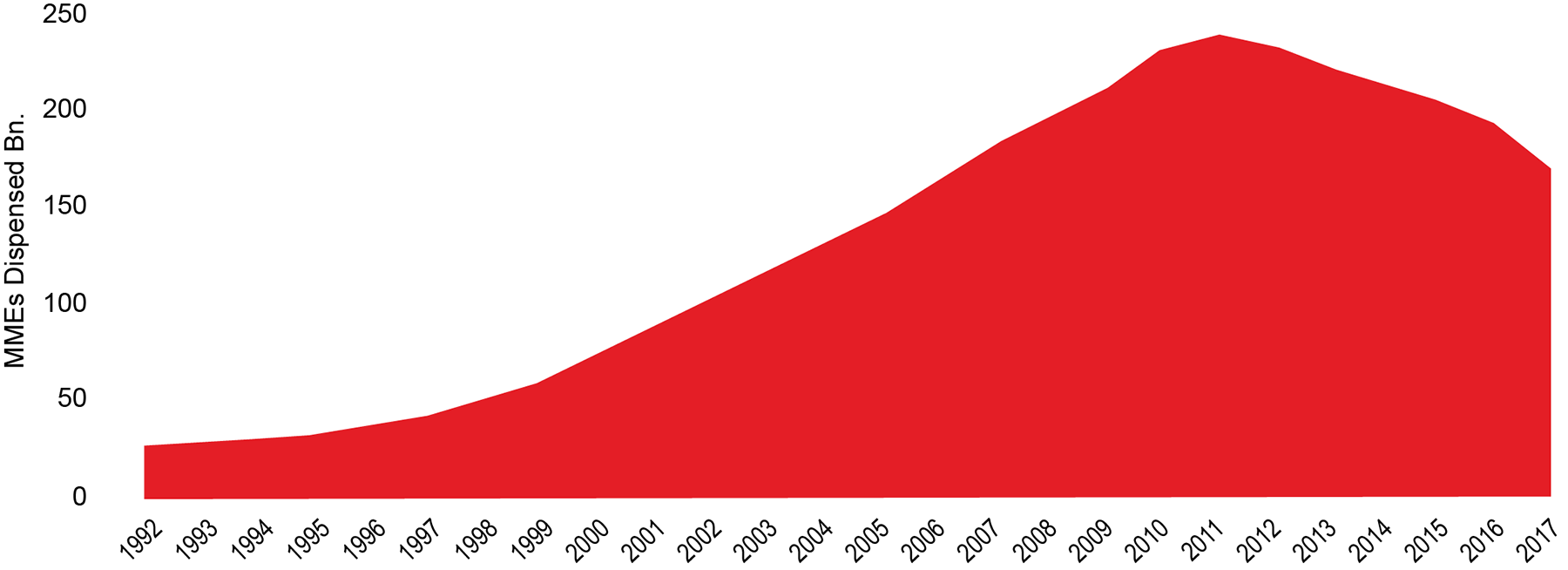I’ve had an interesting view of the opioid crisis as it has unfolded.
As a practicing physician for 30 years, I occupied a front row seat when the trouble began and quickly accelerated, eventually reaching epidemic proportions. Now, as a medical director at RGA, I evaluate opioid use from a much different perspective, analyzing piles of data and determining mortality risk. I find that my time spent “in the trenches” of this crisis plays a critical role in assessing opioid cases and developing underwriting guidelines.
Let’s start at the beginning…
I finished my residency in 1987 and, after a few years in the emergency room, went into private practice. At that time, the consensus within the medical community – leading universities, physicians’ associations, etc. – was that we were undertreating pain. This thinking was crystallized in guidelines such as the Joint Commission on Accreditation of Healthcare Organizations Pain Standards of 2001, which outlined a new set of rights for patients. Patients could now expect:
- Physicians’ ready belief in their reports of pain
- Information about pain and pain relief measures
- A concerned staff committed to pain prevention and management
- Health professionals responding quickly to reports of pain
- Effective pain management
There was nothing inherently wrong with these guidelines, and personally, I was well aware of the value of pain management: My practice included hospice services, an area where pain medication is often an essential component of humane treatment. However, pain management’s elevated status led many physicians to prescribe medication more readily, with the goal of easing pain often superseding all other considerations.
Opioids, which were not indicated for the long-term treatment of chronic pain up until then, became a primary treatment option. More opioids prescribed meant more addicted people – with a new crop of challenges for physicians. Patients began to arrive in greater numbers with complaints of migraines, toothaches, and myriad other aches and pains – even showing up with x-rays and MRIs in hand as proof of veracity or claiming their prescriptions were stolen. We had to lock our cabinets at our practice to avoid theft of drugs and narcotic prescription pads, and on one occasion, a patient actually tried to take my prescription pad right from my lab coat pocket.
Physicians now faced new kinds of pressures. For example, patient satisfaction surveys and internet physician ratings became powerful determinants of a doctor’s payment and business, and an unwillingness to prescribe pain medications often led to negative reviews. In addition, addiction counseling and treatment was time-consuming, poorly reimbursed, and often unavailable, while treatment with opiates was profitable and pain clinics became ubiquitous.
Arguably the biggest pressures came from the opioid manufacturers themselves. Certain narcotics were marketed as non-addicting opioid pain relievers based on industry-sponsored trials. They were purported to be superior alternatives to NSAIDs (aspirin, ibuprofen, etc.), which had been shown to be associated with a higher risk of coronary artery disease, stroke, and GI bleeds. While this may have been true to some degree, NSAID risk was often overstated by opioid salespeople and would prove to pale in comparison to the risks of opioids.
Even before the extent of the burgeoning opioid crisis was fully known, my colleagues and I began to notice a serious problem. With patients continually returning to renew their prescriptions, it was clear these drugs were indeed addictive. While some of us dug in and would not prescribe large numbers of pills without careful scrutiny, addicted patients simply went from doctor to doctor until they found an opening. We were in the midst of an epidemic.
Fast forward to today…
As the impact of the opioid crisis took its toll on families across the country and the data began to flood in, the gravity and extent of the crisis became apparent to all. Medical associations updated their guidelines, legislators enacted new protections, and treatment facilities adopted new best practices. As an example, California instituted a new course in chronic pain management in 2016 that is required to receive or maintain a medical license. The course trains physicians to avoid prescribing large amounts of pain pills and instead, when medication is deemed necessary, provide a short-term supply along with regular check-ins.
The good news: We are making progress. Prescription opioid volume peaked in 2011 at 240 billion morphine milligram equivalents (MMEs) and declined by 29% to 171 MMEs in 2017.
Figure 1:
Narcotic Analgesic Dispensed Volume in MMEs (in billions)

The bad news: The crisis is not yet over. While the medical community, elected officials, and others work to limit access to opioids on the front end, people already addicted remain at risk. The numbers tell the story: According to the U.S. Centers for Disease Control and Prevention (CDC), more than 70,000 Americans died from drug overdose in 2017 – which includes prescription opioids – a nearly 10% increase over 2016 and a two-fold increase in a decade. (Note: One potential sign of hope has emerged as preliminary findings indicate a slight reduction in overdose deaths in more recent months: click here to learn more.)
Having made the transition to insurance medicine at one of the world’s largest reinsurers, I now view the opioid epidemic with a wider lens, while still evaluating individual cases that need special attention. My experiences as a practicing physician inform every aspect of my work at RGA.
For life insurers, the need to account for opioid abuse is urgent. I point underwriters to a variety of red flags that can be found within available evidence – from driving infractions and accidental injuries to multiple prescribing physicians and multiple medications prescribed. Yet while opioid use certainly warrants investigation, I also point out that it need not always merit a high rating or denial of coverage. Some possible scenarios:
- Short-term or episodic (as needed) use without criticism or inappropriate use can generally be assessed quite favorably.
- Chronic use with stable low doses and no criticism or inappropriate use can also be assessed favorably.
- Current chronic use with criticism, inappropriate use – especially combined with benzodiazepines or other sedating drugs such as muscle relaxers – or other red flags is usually highly rated to decline.
- Caution is warranted in individuals with a history of depression even if the depression is not ratable.
For people addicted to opioids, recovery is generally a long-term process and not achieved without an initial in-patient treatment regimen followed by continued counseling and support group attendance. A long postponement period generally is required before life insurance consideration is possible.
As with so many other conditions and behaviors, opioid use does not conform to a one-size-fits-all underwriting process. Distinguishing appropriate and inappropriate use is the key. With greater awareness of the problem and increased efforts and resources to address it, we must reassess the mortality risk that former and current opioid users present and continually work to keep our underwriting guidelines up to speed. After having witnessed the opioid crisis develop firsthand, I know that only through vigilance and genuine concern for the people we serve will we fulfill our industry’s responsibility in helping overcome this national – and growing international – challenge.



